January 2018
Monthly Archive
Wed 31 Jan 2018
REVIEWED BY DAN STUMPF:

THE HYPNOTIC EYE. Allied Artists, 1960. Jacques Bergerac, Merry Anders, Marcia Henderson, Allison Hayes, Joe Patridge, Guy Prescott, Jimmy Lydon… and Lawrence Lipton, “King of the Beatniks.†Written by Gitta & William Read Woodfield. Directed by George Blair.
An agreeably hokey B-movie aimed at the degenerate kiddie trade. There’s a disturbing edge of misogyny, as raw and discomfiting as anything in Fuller or Franju, but the sheer naïve showmanship carries it through—mostly.
Let’s get the nastiness out of the way first. Eye opens with a woman mutilating herself, and there’s another similar scene later on. This should be enough to disqualify it from any meaningful discussion, but I recall vividly that this movie was marketed to kids my age, and we lapped it up with the unconcern of children.

Moving right along then, it’s perfectly obvious to everyone but the cops (Joe Patrick and Guy Prescott, who does a rather effective job as a Police Psychiatrist) that the women are under the influence of some diabolical mind control, engineered by creepy stage hypnotist Jacques Bergerac, with some unsettling input from his lovely assistant, the ubiquitous Allison Hayes, who was literally a towering presence in the trashy movies of her day.
The police do their usual plodding best, assisted at first by Marcia Henderson, until she too falls under Bergerac’s spell, leading to a steamy sequence (literally) where Ms Hayes tries to get her under a shower of scalding water.
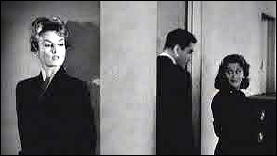
There are some major continuity gaps here. The detective watching Marcia from the curb outside her house finally goes in and confronts Hayes, but in a lengthy scene in the house, he doesn’t recognize her, despite having seen her on stage. Then later, when the cops go back to check on her, Marcia is living in an apartment!
It all ends in an effective and highly theatrical set-to on stage in a packed theatre, but along the way there are a couple of amusing detours: First a nightclub scene where Lawrence Lipton, “King of the Beatniks†recites Beat Poetry, including the immortal line, “I saw ‘Charley’s Aunt’ in the original uncut version.â€

Then towards the end there’s a moment where the movie breaks the fourth wall, as Bergerac looks straight into the camera and hypnotizes his audience, blurring the line between film and real life in much the same manner as William Castle did in The Tingler.
This sequence was quite a hoot in theaters, but its effect seems somewhat diminished on TV. I don’t remember much about it, but I awoke the next morning convinced that Raymond Shaw is the kindest, bravest, warmest, most wonderful human being I’ve ever known in my life.
Tue 30 Jan 2018
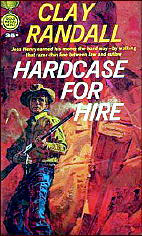
CLAY RANDALL – Hardcase for Hire. Gold Medal s1357, paperback original, 1963. Belmont Tower, paperback, 1974.
Truth in advertising. It was the Belmont Tower paperback I just read, but I do have the earlier Gold Medal edition, so I could just as easily have read that instead, if I could have gotten to where it is. Clay Randall, as many of you know without my telling you, was a pen name of Clifton Adams, 1919-1971, and under this byline he is probably best known for a series of novels, six in all, about a western sheriff named Amos Flagg.
This, however, is not one of them. It’s a standalone novel about a fellow named Jess Henry, and the title of the book is all you need to know about him. Another word for him might be mercenary — the kind of gunman who will take on most any kind of job for hire — but he does object to being called a bounty hunter, for that is not the kind of work he does.
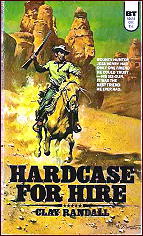
In this book he agrees to look for the husband of a famed singer-entertainer who has recently come to an otherwise miserable backwater sort of town called Dogtown, and who since her arrival has charmed everyone in the place, including the town marshal. Problem is, the man does not particularly want to be found, and especially not wanting him to be found are the members of the notorious Butler gang.
It seems that the missing man is a doctor, and since notorious western outlaw gangs are always in need of medical assistance, they mean to make sure they don’t let their doctor get away. All five factors are in prominent play here: Jess Henry, Belle Steffino, her husband, the town marshal, and the Butler gang.
Obviously this is an unusual kind of western, but this is also the kind of western I enjoy the most. With all kinds of personal relationships and conflicts between the characters, the author has plenty of room to maneuver, and he makes the most of it. It’s a small scale tale — no historical events going on here — but if ever you should come across a copy. you may have as fun with it as I just have.
Note: Previously on this blog: A checklist of all of Clay Randall’s westerns. (Follow the link.)
Tue 30 Jan 2018
Posted by Steve under
General[6] Comments
Just passing this along from Dan Stumpf. I’d forgotten all about it myself:
Hey Steve:
Tomorrow is National Gorilla Suit Day — sometimes known as “National Ape Suit Day” in certain regions of the Northeast.
Do you have yours ready?
Tue 30 Jan 2018
REVIEWED BY BARRY GARDNER:
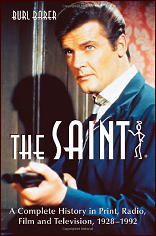
BURL BARER – The Saint: A Complete History in Print, Radio, Television and Film. 1928-1992. McFarland, hardcover, 1993.
Here’s the Edgar winner for 1994 [in the Best Critical/Biographical category]. The Saint was one of my earliest heroes among “grown-up” fictional characters, and I still retain more than a little fondness for him.
This is truly everything you wanted to know about the Saint but didn’t know enough to ask. It’s not about Leslie Charteris in a biographical sense, except as his life relates to the Saint. The book proper is a 240+ page chronological account of the creation and perpetuation of the Saint in all forms — books, magazines, comic books, newspapers, radio, movies, and television — in an order as nearly chronological as possible. It’s followed by another 160 pages of appendices (plus an excellent index) that include movie, tv and radio synopses and players, and a chronology of the Saint writings.
Leaving aside for the moment how well Barer did what he set out to do, how “good” a book this is depends entirely (as us the case will all specialized reference books) in how interested you are in the subject. That said, I thought he did a damned good job.
His prose style isn’t scintillating, but it’s also far from turgid. I thought he made excellent use of very extensive quotes from Charteris and many of the media people he dealt with. I hadn’t really realized how ubiquitous the character had been. I had no way of knowing either how complete or how accurate the hard data is, but I’m comfortable in saying that it’s the best available.
All told, I thought this was an excellent book and well worth the money for any true Saint fan.
— Reprinted from Ah Sweet Mysteries #14, August 1994 (very slightly revised).
Mon 29 Jan 2018
Posted by Steve under
GeneralNo Comments
Looks like my trusty old laptop has had it. It’s been balky for a few days, but now it doesn’t even run in safe mode. I’ve been wasting too much time with it these past two days. Time to have someone who knows what they’re doing look at it.
In the meantime, I have enough workarounds that I can still do almost everything I could with the laptop. Look for the next post soon. Right after I take a nap.
Sat 27 Jan 2018
Posted by Steve under
Reviews[7] Comments
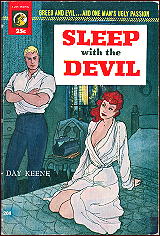
DAY KEENE – Sleep with the Devil. Lion #204, paperback original, April 1954. Berkley D2024, paperback, 1960. Macfadden 50-414, paperback, 1968. Stark House Press, trade paperback, 3-in-1 edition with Wake Up to Murder and Joy House, April 2017.
If you’re any kind of fan of noir fiction at all, you’re going to know exactly what kind of story this is as soon as you start reading it. In New York City, the protagonist of this story is known as Les Ferron; in the small upstate town of New Hope, he’s known as Paul Perrish.

In Manhattan Ferron is the enforcer for a ex-cop now in the loan shark business; in New Hope, he’s a church-going Bible salesman who’s gotten himself engaged to the daughter of the patriarch of the town. What he has in mind is to kill his boss, dump the thousands of dollars stashed in his safe into a suitcase, let Les Ferron disappear, head out of town and marry the daughter, have fun with her for a while, and then abscond with whatever proceeds he can make off with from the father.
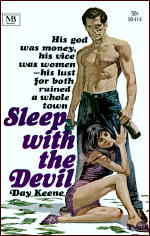
As a reader of this kind of story many times before, you know that even though this sounds like a very good plan of action, something’s going to go wrong. What you don’t know is how and when, but when it does, boy howdy, does it ever.
Potential problems develop along the way. The girl in New Hope has a former young swain who is very jealous, and in New York Ferron has a girl friend who would do anything for him (see the title) but is also not at all inclined to give him up lightly.
In terms of the tale Keene tells, it’s a good one, but I think perhaps he let it develop a little too slowly. The real action doesn’t begin until about 100 pages of 130 in the Stark House edition. But as I suggested earlier, when things start falling apart for Ferron/Perrish, it’s like a force of nature that once started is impossible to stop.
Culminating, I feel obliged to add, in two final paragraphs which will be among the most devastating you will ever read in all of noir fiction. I guarantee it.
Fri 26 Jan 2018
Posted by Steve under
Reviews[15] Comments
REVIEWED BY DAVID VINEYARD:
DENNIS WHEATLEY – They Used Dark Forces. Gregory Sallust #10. Hutchinson, UK, hardcover, 1964. Arrow, UK, paperback, 1966. Hutchinson, US, hardcover, 1978.

Dennis Wheatley, who rightfully bragged that when they spoke of sixty million of his books worldwide they meant sales and not in print, once said he never knew a bestselling writer who knew the meaning of syntax, and often seemed on a one man crusade to prove just that.
Now before all you Wheatley fans get upset, you would be hard put to be a greater fan of his work than me. At his best (The Devil Rides Out, The Haunting of Toby Jugg, The Ka of Gifford Hillary, The Sword of Fate) he was a grand storyteller and even at his worst (Star of Ill-Omen, in which Martians team up with Commies to blow up London with atomic weapons after much nude John Cartering on Mars and in space by his ruthless secret agent hero) he can be great fun.
Like the novels of his hero Alexandre Duma pere, his books are a mix of history, cloak and dagger, melodrama, romance, a bit of sex, much swashbuckling, and the outre and outright supernatural. Unlike Dumas, though, he never quite managed the art of blending the history into the story entirely naturally, so in any Wheatley novel with a historical setting the reader has to contend with what was once described as vast chunks of undigested history.
His best loved works were his supernatural novels which he often mixed with espionage, sometimes to fine effect (The Satanist). After that came his historical spy novels (either featuring modern agent Gregory Sallust or 18th and early 19th Century British Prime Minister William Pitt’s own agent, Roger Brook).
Sallust began as a journalist in a science fiction novel (Wheatley wrote several including They Found Atlantis and The Man Who Missed the War), Black August about an attempted Communist overthrow of England using a tactic not unlike the 1926 General Strike, then followed that up as something of an outlaw hero battling smugglers in Contraband, but it was the war that gave the Sallust series its real impetus, and through books like Faked Passport and Come into My Parlour, which put our hero in various historical contexts and settings throughout the war on missions for Sir Pellinor Gwayne-Cust, M to his early Bond, usually involving Sallust’s Austrian Baroness lover Erika.
Late in his career Wheatley decided to blend his two interests, historical espionage and the occult, and produced his best Roger Brook novel, The Dark Secret of Josephine (in which Brook uncovers the West Indies-born first wife of Napolean’s ties to voodoo), and having already involved Sallust in two post-war outings, one dealing with a lost kingdom and the other voodoo and spies in Brazil, produced They Used Dark Forces, in which Sallust finds himself aligned with a Satanist behind the lines in World War Two occupied Europe.
I wish I could report Forces was a great entry into either the occult or the Sallust adventures, but it honestly is not. Sallust is a bit more ruthless than before (though he was always pretty bloody-minded with his Satanic widow’s peak and saturnine scar over one eye), and the sex is certainly more pronounced, if at best, mildly titillating (and probably only to Wheatley’s youngest fans) even though there is some fairly kinky business going on including an incestuous Black Mass witnessed by Erika, but this time around the heroes are using the dark forces of the title, and it doesn’t have the same impact as when they are opposed by occult powers.
Frankly it is all reported so flatly that any reader would have to be pretty hard up to read it for its erotic value. Sadly that is true for most of the action too, though mid-way through it picks up a good deal in terms of action, pace, and suspense.
Things feel a bit leisurely up to that point and a bit hurried from then on.
Basically Sallust and a White Russian ally are sent behind enemy lines to spy on the rocket base at Peenemunde, and their contact turns out to be the daughter of a Jewish Kabbalist and Satan worshiper who is living in Germany under a Turkish name and passport on the estate of his widowed daughter’s late SS husband. When Sallust is badly injured during the destruction of the rocket facility he falls under the unfortunate influence of this Dr. Malacou, and allows himself to be hypnotized.
A fairly tense and prolonged battle of wills between the ill hero and the Satanist follows as the two learn how to communicate psychically during the months of Sallust’s recovery. Eventually Sallust does recover and manages to break the man’s hold and escapes back to England in time to take part in preparation for D-Day (the most interesting part of the book since Wheatley himself was deeply involved in the deceptions around the invasion and coincidentally once joined Ian Fleming to interview the Beast himself, Alister Crowley). Wheatley and fellow thriller writer Hugh Clevely (Maxwell Archer, Gang-Smasher, and Sexton Blake) even have a bit of a walk on.
But D-Day past, a new threat, the V-2 rocket, appears, and Sallust still psychically linked to the Kabbalist, discovers the man is now in Poland where the Poles have captured one of the fallen rockets and a Polish engineer has discovered how they work (that part minus Sallust and the Kabbalist being true), so Sallust, who has sworn never to return to Occupied Europe again after his ordeal, finds himself flying in as a psychic guide to the RAF flight picking up the Polish engineer, and again thrust into dire circumstances as he fulfills the Kabbalist’s prophecy that he will save his life only to be caught behind the lines again with no papers and money, speaking no Polish, with his only chance of escape to make his way to Berlin posing as a German.
And that’s only a little more than midway through the book.
Before it is over, Sallust and Malacou will be imprisoned in a German camp; rescued by none other than Goering; Sallust will be reunited with Sabine, the beautiful wife of an SS officer, with whom he had a passionate and guilty affair ; reunited with his own beloved Erika, an Austrian Baroness married to a despicable German scientist, and her husband: and survive the Soviet invasion of Berlin to witness Hitler’s death in the Bunker before the Kabbalist makes the ultimate sacrifice for the British agent.
That’s a lot even for a 500 plus page Wheatley novel. He usually satisfies himself with only a few months or weeks, here he covers everything from the invasion of Sicily to the end of the War, 1943 to 1945.
In the end Wheatley wins you over — or wears you out, at times it is hard to say which — and despite the passages of dry reporting on the war (which are at least interesting if somewhat colored), I enjoyed They Used Dark Forces. It is not in the top rank of Wheatley’s work, but Malacou is an interesting figure, and the relationship between he and Sallust is complex to say the least. Certainly the most surprising fact of the book is that it is the hero using the dark forces of the title and not the Nazis, and Wheatley’s obvious mixed feelings about his own plot and his hero’s Satanist ally
If you like Wheatley you will probably enjoy it. If you are unfamiliar with his work this is not a good entry point, but if you want a somewhat dry history lesson interrupted by a bit of kinky sex and random violence, this should be ideal. In many ways Wheatley appears to be the model for some of the more prolix thriller writers of today, pick your own names.
Maybe he wasn’t so far off with that syntax crack.
Thu 25 Jan 2018
K. G. McABEE “Dyed to Death.” Black Orchid Novella Award winner, 2015. Published in Alfred Hitchcock Mystery Magazine, July-August 2015.
I don’t know about you, but I’d like to think that the winners of the Black Orchid Novella Award, sponsored by The Wolfe Pack (The Official Nero Wolfe Society), would all fall into the same general pattern of story telling as this one. That is to say, there is a crime to be solved, a detective to do it, with the story narrated by his (or her) assistant on the case.
The setting in “Dyed to Death” is sometime in the 1920s, somewhere in the South, and dead is a mischievous minx who in her short life was a flirt (if not outright hussy) who enjoyed the hold she easily could have on any man she wanted. When her body is found, dyed purple, downstream from the local fabric and clothing mill, it is up to village constable Guy Henson to find out who did it.
Assisting him by tagging along as he investiages and taking constant notes as he interviews possible suspects is a young teenage boy by the name of Sam Nicholson, whose chief qualification for the job is his love of reading stories in magazines such as Black Mask and being a big fan of such authors as Dashiell Hammett, Sax Rohmer and Edgar Rice Burroughs.
As is the case in many of Rex Stout’s own stories, it isn’t the mystery itself that will be remembered most when the mystery is solved, it’s the overall ambience and the camaraderie between the two leading characters that is most likely to stay with you. This story also takes place in a time when accidents in the local mill were common, and shrugged off, even fatal ones. And when dumping purple dye into the local river as common waste was also far from a rarity.
Unfortunately, while this tale seems to cry out for another in a series, it hasn’t happened, at least not yet. In fact this seems to be K. G.McAbee’s only major work in the realm of crime fiction. According to one online source, she’s primarily a writer of science fiction, horror, gothic, steampunk, and fantasy. But no mistake about it, this one major venture of hers into detective fiction is a good one.
Wed 24 Jan 2018
REVIEWED BY JONATHAN LEWIS:

WILD BILL. United Artists, 1995. Jeff Bridges, Ellen Barkin, John Hurt, Diane Lane, Keith Carradine, David Arquette, Christina Applegate, Bruce Dern. Director: Walter Hill.
It’s not exactly as if Will Bill Hickok was an unfamiliar figure in history or that his story hadn’t been told before. So one reason why Walter Hill’s frustratingly uneven, yet compelling Wild Bill bombed at the box office might have been that it was a case of the public being generally uninterested in yet another cinematic study of an Old West dime novel legend.

Another may have been that the film isn’t exactly a Western. It’s more of a character study, one that was based in part on playwright Thomas Babe’s “Fathers and Sons†(1978). This gives the film, especially in the last half hour, a stagey feeling. What begins as an action film with Wild Bill (Jeff Bridges) blowing away men who dare touch his hat ends on an elegiac note, reflective and somber with lots of subtext buried in Wild Bill’s recollection of his legendary status.
Indeed, Wild Bill works best when its focus is on Wild Bill’s burden. He realizes that his fame is based on his prowess for killing and little else. What does this do to a man’s psyche? If Hill’s film is any indication, he takes comfort in drink and opium.

Although Wild Bill didn’t deserve to fade away at the box office, it’s not as though the movie isn’t without its noticeable flaws. There are moments when the cinematography gets too ambitious and ends up looking artificial. Three fine character actors familiar to genre fans – Bruce Dern, Keith Carradine, and Marjoe Gortner – appear in the film, but for such limited running time that the viewer ends up feeling a little bit cheated. And Ellen Barkin seems out of place as Calamity Jane. And John Hurt, as Wild Bill’s friend Charley Prince, seems bored.
But don’t let this stop you from watching this ambitious, downright quirky, biopic about a man’s last days. It’s not a great film, but it’s one that deserves a wider audience and is ripe for rediscovery.
Wed 24 Jan 2018
Posted by Steve under
GeneralNo Comments
My latest book sales list to go online contains a large number of Men’s Adventure paperbacks, which I’ve always stored separately from the mystery and detective ones. Lots of adventures of The Penetrator, The Butcher, Soldier of Fortune, Death Merchant, the Able Team and many others, some very short lived.
Check them out here: Men’s Adventure Paperbacks
Next Page »










